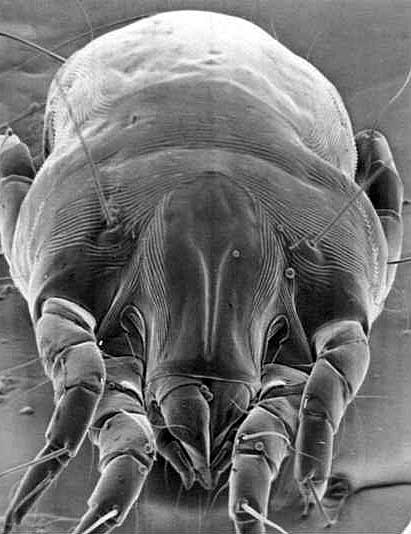Meet the not-so-humble house dust mite known in scientific circles as dermatophagoides pteronyssinus.

Dermatophagoides pteronyssinus – Credit Immunotek.
Isn’t she beautiful? Well, she’s about to give birth. So long as there’s plenty of food around and a warm place to stay, her 60 or so children will do the same in about the next two weeks – well, at least her 30-odd daughters will. And if her grandchildren have plenty of food and so forth, we will have an infestation in no time. Even though she and her kin are tiny and invisible to the naked human eye, they sure can have a big impact.
And as science is increasingly revealing, they can be so harmful to our health that, over time, they can dramatically affect our quality of life and even our longevity.
But worry not, for there is a solution. Firstly, it’s important to know that we can not ever get rid of every dust mite. They are ubiquitous to humankind. They feed on human skin scales. And so wherever you find a human, you will find more than a few dust mites. But it’s their excessive numbers that we aim to control. Our immune system can tolerate their presence to a degree. When we encounter them in overwhelming concentrations, they can become a problem. Particularly for the immunocompromised. And so the key is the management of their numbers. And the underlying premise is to live dust-free.
Microscopic free-floating dust mite poos
The dust we are discussing here is microscopic. It’s comprised of a myriad of things, but the main allergenic ingredient we are talking about here is dust mite faeces. If you think a dust mite is tiny, imagine how tiny their poos are. And therefore, it’s difficult to remove this invisible dust from our homes with traditional cleaning methods. It wants to float. Therefore, we are unaware of how it evades our best cleaning efforts because we can’t see it. That is, at least until it settles again en masse on open surfaces. Then we can wipe some of it up, but much of it goes airborne again when we do. And so, we must embark on a journey of understanding the nature of dust and how to control the bulk of it in our living environment.
On this site, you will find loads of information and articles about the dus-free giving principles and how to achieve this in your own life. If you have specific questions, please ask them here, and we would be delighted to make a video answer for you. We wish you well on your journey of living a dust-free life and overcoming your allergic reactions to Dermatophagoides pteronyssinus.

